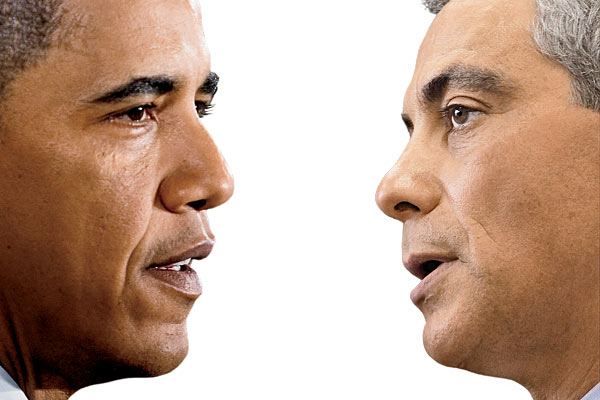By Cassie Walker Burke
With additional reporting by Marcia Froelke Coburn, Quinn Ford, Geoffrey Johnson, Andrea Scott, and Michael Solomon

Obama’s announcement came out of nowhere in a speech last June: Chicago would be the first U.S. city outside of Washington, D.C., to host a NATO summit. Cue the relentless stream of news bulletins: Hello, G8! Goodbye, G8! A Tsunami of Protesters to Seize the Loop! Fancy Shin Guards for Police Horses! Wait, what?
Never has the scrutiny on Chicago been so intense—and never have the stakes been so high for Mayor Rahm Emanuel. During the May 20–21 summit centered at McCormick Place, he has to keep 7,500 foreign guests, and the 2,000 journalists who will trail them, entertained, impressed, and, above all, secure. Past summits of this magnitude have been protest magnets. But despite calls for peaceful demonstrations, there is a combustible element. “These things have a life of their own,” says Kalle Lasn, the cofounder and editor of Adbusters, the Canadian magazine that spawned the Occupy movement.
If Rahm and his team—which includes organizer Lori Healey—pull off a smooth event, the city would benefit from international exposure and a multimillion-dollar payoff down the road. “These summits will help promote Chicago as a prime destination for travel, tourism, and trade,” the mayor told Chicago in a statement.
But if Rahm’s team blows it, they will find it hard to lure other major events here (a second shot at the Olympics, anyone?). And they’ll cause significant problems for Rahm’s old boss. This is a presidential election year, after all. The last thing Obama wants is to look foolish in front of the electorate, not to mention his international peers.
Powerful politicians aside, the summit is a watershed weekend for Chicago because of the global repercussions of the talks here. Last time NATO met, in 2010, its partners announced they would withdraw from Afghanistan in 2014. But the devil is in the details, and how exactly to exit the war-torn country without creating an Asian sinkhole is a billion-dollar conundrum. So is defense in a time of global belt-tightening. “The question is, how do we protect ourselves, and how do our partners protect themselves?” says Rachel Bronson, vice president of the Chicago Council for Global Affairs, who predicts that the summit will go down in history as “Chicago 2012.”
The good news for Chicagoans: Though this megaweekend will cause you some headaches from summit-related street closures, far fewer crowds are expected than for, say, Lollapalooza or the Air and Water Show. Plus you can take advantage of cultural programming, an international chef exchange, talks with foreign policy experts, and celebrity spotting (French first lady Carla Bruni-Sarkozy could make an appearance—if her husband is reelected in the weeks before the summit, that is).
See “NATO Weekend Survival Guide” for a cheat sheet that maps out where the key stuff will be happening, so you can plunge in—or stay far away—as you please.
QUICK FACTS
What is NATO? The North Atlantic Treaty Organization, an alliance formed in 1949 by the United States, Canada, and ten European countries to defend North America and Western Europe
Who’s coming to the summit? Heads of state and defense and foreign ministers from the 28 current NATO partners, as well as representatives of the 22 countries fighting alongside NATO in Afghanistan
What are the protesters rallying around? One big mantra is “We are the 99 percent,” a redistribution-of-wealth ethos with Robin Hood as an emblem. Some anti-war activists paint NATO as the muscle behind the G8 plutocrats.
What else is on the agenda? The organization will also weigh its relationship with Russia, North Africa, and the Arab world, as well as “smart defense” strategies that provide the most bang for the buck in austere times.
Where can I soak up some brainpower? Hear former secretary of state Madeleine Albright at the Auditorium Theatre on May 2; for info, 2012summits.org. Keep reading for more ideas.
Photography: (Obama) © Brooks Kraft/Corbis; (Emanuel) Nancy Stone/Chicago Tribune


